I made some changes to the way I clean my flat a couple of months ago: scaling back on the number of products I use, mixing my own cleaners from bulk-bought ingredients, and buying most of the rest from an enlightened manufacturer I want to support. My flat’s as clean as before, I’ve reduced the environmental impact of my cleaning and I’ll save money over the long term.
While some of the new products and techniques were more successful than others, overall I haven’t looked back from making the change. I would recommend anyone reading to consider doing the same in the new year. That’s why I wrote this post.
There are four steps on this journey: buy products and ingredients, set a schedule, make the products, start cleaning! Much more (likely way too much) on each step below.
Why I did it
A few things made me decide to go on this eco cleaning journey in the first place.
First, a tweet about soda crystals. Specifically, this thread on Twitter about Dri-Pak, a family owned British company that makes a bunch of different ‘traditional cleaning’ products.
This led me to Dri-Pak’s (delightful) website, which is loaded with how-tos.
Second, a stainless steel cleaner. This was the cleaning potion that broke the camel’s back, if I’m allowed to mix metaphors. I’d bought it at a Lakeland outlet near me over the summer, tempted as ever by the cool bottle. I’d been living in my own place for a year or so, and, being an obsessive neat freak, had accumulated an arsenal of brightly-coloured, highly specialised and quite expensive cleaning bottles and potions.
I tried this particular product, not expecting miracles, and noting the severe overlap in utility with Viakal, my previous ‘go to’ for cleaning metal shiny bits. The effect was pretty disappointing. I slotted it in place in my cleaning cupboard, and wondered if some kind of obscure con had been perpetrated on me, that I felt I had to spend a fiver on yet another specialist-use potion that didn’t do anything that… special?
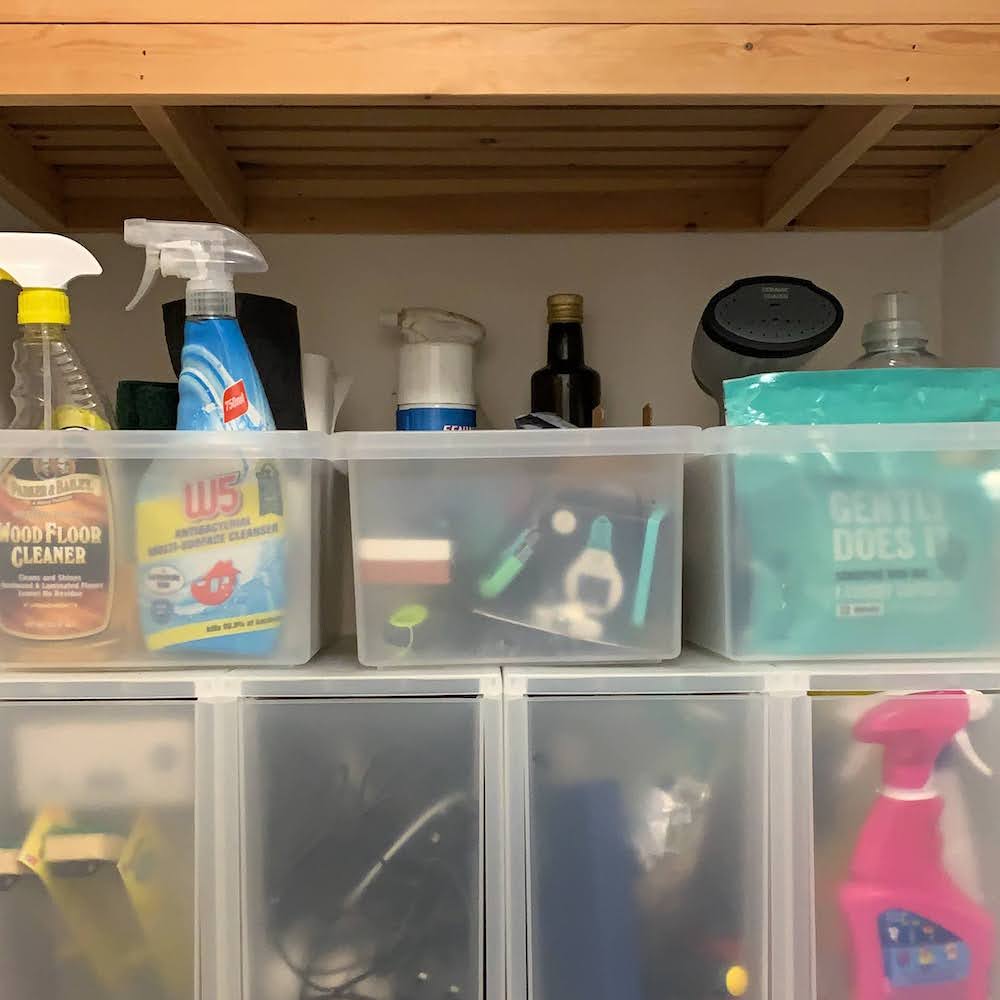 My highly un-eco-friendly cleaning cupboard before I started, including washing tabs, fabric cleaner, wood floor cleaner…
My highly un-eco-friendly cleaning cupboard before I started, including washing tabs, fabric cleaner, wood floor cleaner…
Third - having felt conned, I took a newly-critical view on the place where the con artists hang out, Instagram! I’d been following various cleaning accounts on there, and was getting a bit turned off by the relentless shilling of new products, all accompanied with an affiliate link and a minuscule #adaff hashtag. Yes this is a slam of the P&G sponsored Instagrammer Mrs Hinch and her ilk! These “cleanfluencers” get paid via affiliate links to cleaning products, which naturally means they’re induced to promote ever more exotic potions and solutions, when actually going back to basics would do the job just as well, for far less environmental and financial impact.
So when the excellent Michelle Ogundehin posted about her own clean cleaning journey on Instagram, I was a captive audience. Michelle - who’s been blocked by Mrs Hinch after calling her out on shilling toxic products - also mentioned the book Clean and Green by Nancy Birtwhistle as a great source of information.
I ordered and devoured this amazing book like a plump Belgian bun (Nancy won the Great British Bake Off a few years back, too). Clean and Green, which I’ll be cribbing relentlessly from for the rest of this post, breaks down the what and the how of eco cleaning and also contains recipes for mixing your own products.
So, I’d done my research using Dri-Pak’s website, Michelle’s story highlights and, above all, Nancy’s book. I had a couple weeks off as I’d left my old job, before joining the new one. I had a cupboard full of specialist toxic cleaning products that I suspected I didn’t need. Time to draw up a plan of attack and take the plunge into eco cleaning.
Some caveats before I start
Everything I write below comes with acknowledgement of the following facts, that I want you to know I’m conscious of:
- A lot of the information below will be old news to any reader who’s cleaned for a while. But the information was enough of a revelation to me the braindead Hinch follower that I thought it worth sharing with others.
- I work sensible hours and make a decent wage, meaning that I had and have time to plan and execute a cleaning schedule, and the funds to spend what I needed to for the big up front shop.
- I live alone in a small flat in London. Which means there isn’t that much surface area to clean, and only me to mess it up.
- While my cleaning is more eco friendly than before, I’m far from eco perfect. I order Deliveroo a lot and a lot of my groceries come wrapped in plastic. None of this should be read as me preaching from a Greta Thunberg-approved pedestal. I improved some things, and need to improve more in future.
- Particularly relevant to the laundry section below: 80% of my clothes are cheap (very un-eco friendly fast fashion), black or navy, and made of cotton. I’m a pretty cheap laundry date in other words, with no lacy, white or expensive clothes to worry about.
Step 1 - buy stuff
The first step for the switchover for me was to buy what I needed: the ingredients to make my own cleaning products, some standalone products (all Dri-Pak), and some bottles to store the products in.
The standalones can all be bought in most supermarkets. You can buy direct via Dri-Pak if you want, or there are cheaper and slightly bulkier non-branded versions of exactly the same products on sale at Wilko. I went for convenience and ordered the lot as part of my weekly groceries shop, specifically:
- Several bags of soda crystals (the king of all cleaning products, loads of uses, explained below)
- 1 bottle white vinegar (loads more uses, you can bulk-buy a nicer-smelling alternative on Amazon) that’s also a major component of a lot of the self-mixed products
- 2 packs liquid soap (laundry)
- 1 bottle liquid soda crystals (oven)
- 2 packs citric acid (general descaling, toilet).
My big Amazon shop for ingredients and storage was as follows:
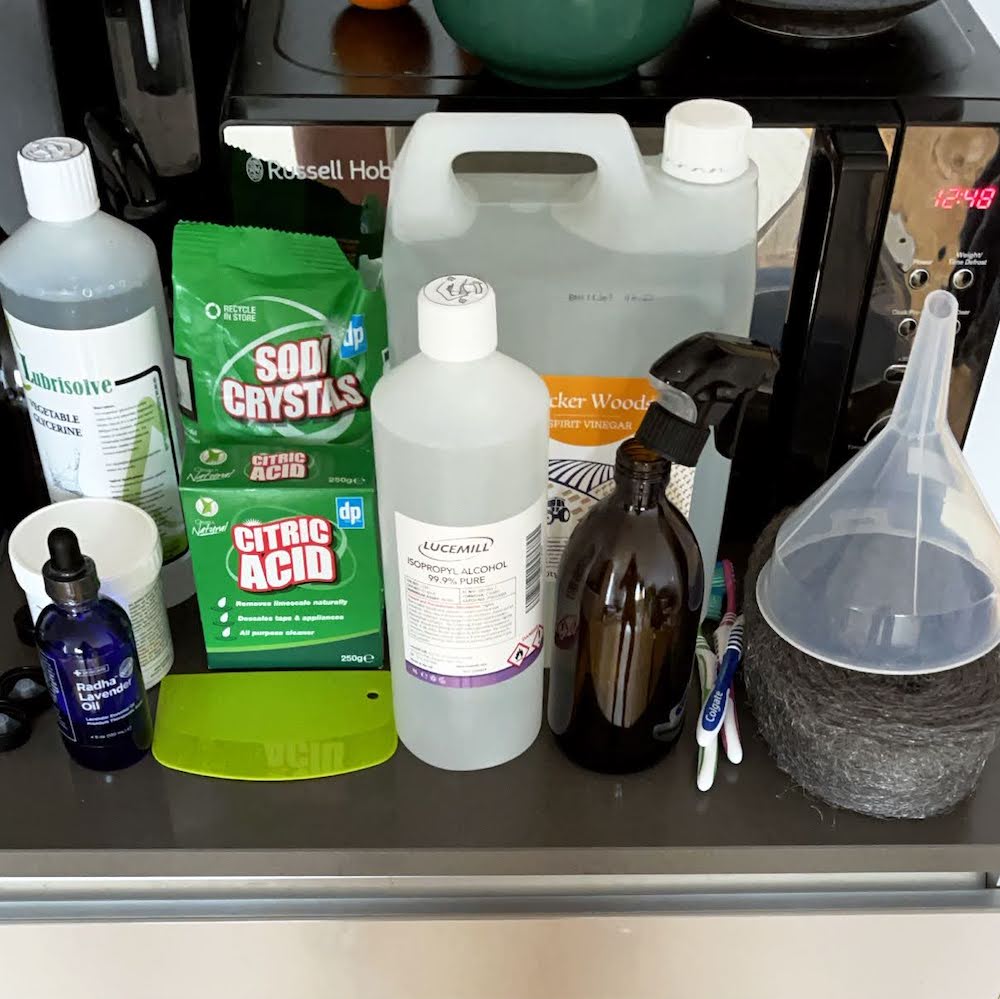 Some of the haul.
Some of the haul.
- Measuring scoops, mainly for doling out the soda crystals and getting accurate measures for making the products, but I’ll use them in the kitchen longer term too.
- Glass bottles for the self-mixed products - I ordered six in total, on Nancy’s advice, in brown glass to protect the contents from the sun.
- Plastic funnel for getting the ingredients into the bottle without spilling!
- Eco-friendly washing up liquid - not as effective as the toxic alternative, but does the job acceptably. I bought a five litre refill later so I didn’t keep buying plastic bottles.
- White oil paint marker - definitely an optional extra, but I wanted to be able to label the bottles without needing to use any applied label that could flake off or get water damaged
- Big tub of sodium bicarbonate - can be used in cooking too.
- Surgical spirit - could also be useful as a disinfectant for those still deluding themselves that COVID isn’t an airborne disease, but either way it’s used in all-purpose cleaner.
- Xanthan gum - used for some of Nancy’s more esoteric potions, mainly around specialist stain removal. I haven’t used it yet.
- Vegetable glycerine - used in dishwasher rinse aid.
- Essential oil any flavour - I chose lavender. The purpose of this ingredient is solely to make the self-mixed products smell nice when applied rather than due to any inherent cleaning properties. Many of them use vinegar, which has a definite whiff of the chip shop.
- Sodium percarbonate - aka ‘green bleach’, an alternative to chlorine bleach which is pretty much one of the most toxic substances known to man! Warning: this could be labelled as a bunch of different things (mine was called “home brew beer wine cleaner sanitiser”) so you need to make sure the active ingredient is correct.
 My sodium percarbonate came vacuum-packed, from ‘biggerjugs.co.uk’
My sodium percarbonate came vacuum-packed, from ‘biggerjugs.co.uk’
I spent just over £100 all in, mainly on the Amazon shop, and including the cost of Nancy’s book.
Step 2 - organise a schedule
I’m an avid user of to-do apps, with Todoist still my tool of choice. Using recurring tasks in their own Cleaning category has helped me stick to a realistic schedule, and it’s especially handy for splitting out weekly tasks - for example, cleaning bathroom surfaces - from less frequent tasks like descaling the kettle.
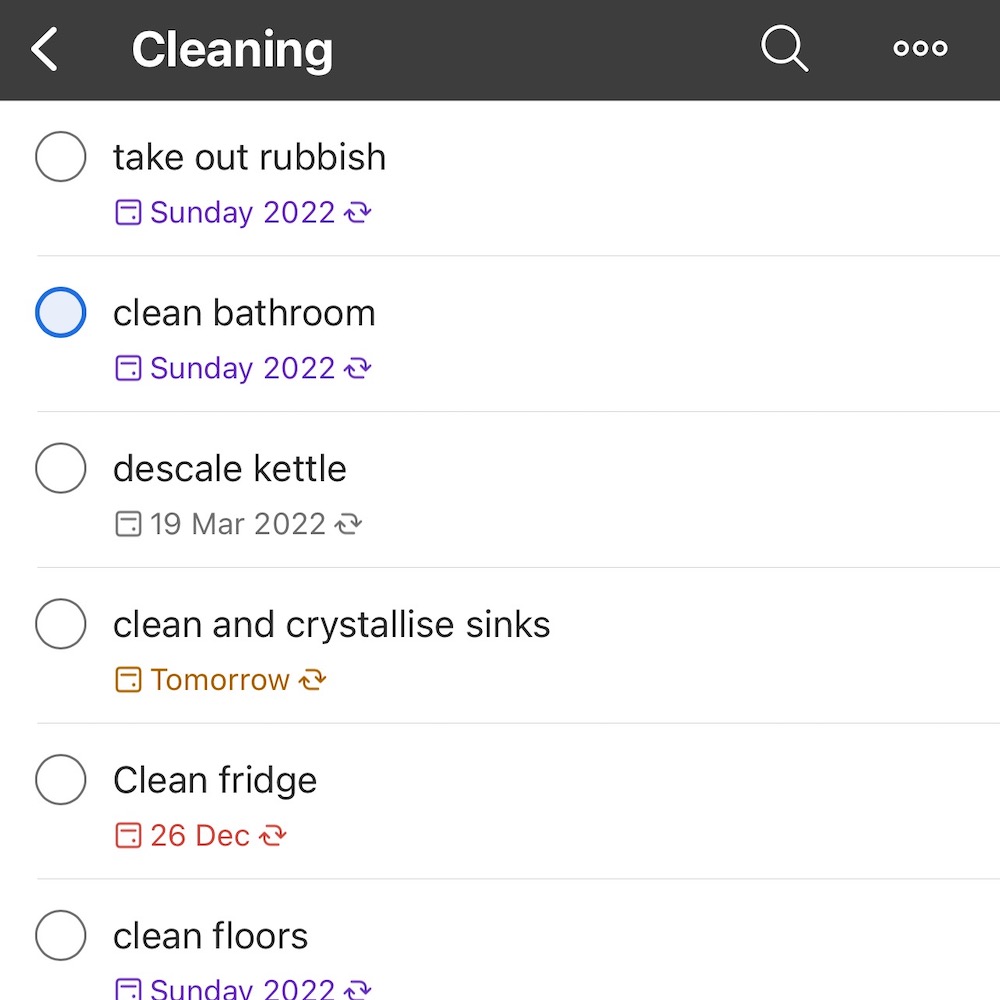 My cleaning tasks. I do most of it on Sunday. I’m overdue cleaning the fridge
My cleaning tasks. I do most of it on Sunday. I’m overdue cleaning the fridge
I do most of my cleaning tasks on a Sunday morning, because that’s my most consistently free time of the week. I’ve found it helpful though to break out other less frequent tasks, like cleaning the fridge or washing windows, onto alternate Saturdays so that I don’t have a massive block of tasks all on one day.
That said, if you’re not the kind of person that gets motivated to do stuff by pinging tasks off a queue in an app, then the above isn’t going to help much. But, as with so many other things, it’s Todoist that’s kept me on track for scheduled cleaning.
A couple of months down the line, I’ve also got a rough idea of how long each of the cleaning products I make will last me, meaning I can add in recurring tasks to mix up another batch of each at appropriate intervals. Speaking of which…
Step 3 - make stuff
Following my big Amazon shop, I had six brown glass bottles to work with, and six recipes from Nancy’s book for products that I felt I’d use the most. I blocked out an afternoon to mix everything up, which was way too generous, as I was actually done in an hour or so.
 Prepping for mixing some products!
Prepping for mixing some products!
I made:
- All purpose cleaner
- Floor cleaner
- ‘Toilet magic’ - later rebranded as ‘Pure magic’ by Nancy
- Dishwasher detergent
- Dishwasher rinse aid
- Cream cleaner
Included below are the recipes for everything except for the bicarb-based cream cleaner - intended for stain removal and degreasing, which I actually haven’t found occasion to use yet.
As you’ll see, the actual core ingredients don’t vary that much for the ‘big three’ of all purpose, floor and pure magic, but the uses of each product are pretty distinct.
Step 4 - clean stuff
New cleaning product in one hand, Nancy’s book in the other, I then tried… actually using them. Success rates varied, full details below.
Laundry
The one change that has been the most dramatically successful, and the thing in Michelle’s stories that hooked me in to even starting this journey in the first place, has been with laundry.
Previously, I used an Ariel washing tab and a glug of supermarket own brand fabric conditioner on my weekly laundry load. As everything was generally made of cotton, I washed on my machine’s pre-programmed 60 celsius ‘cotton’ wash, and then used the built in dryer for another couple of hours. My washing was generally stiff, brittle and had a distinct whiff of chemicals.
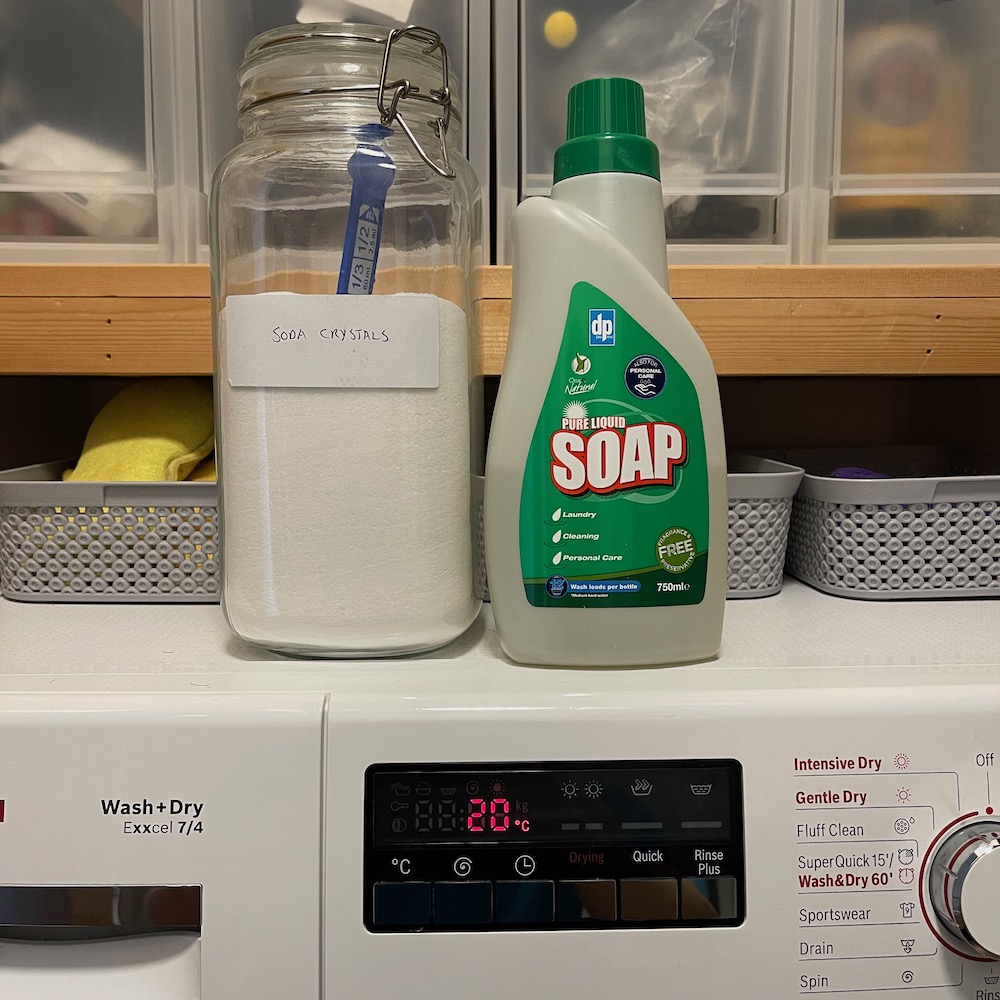 All you need for laundry
All you need for laundry
My laundry is now odourless and soft. Each wash is cheaper for me and better for the environment in general. I go full Dri-Pak, using a single largish scoop of soda crystals (in the left hand compartment of the drawer) and a capful of liquid soap (in the drum). That’s it! The soda crystals soften the water - essential as I live in a hard water area - and the soap cleans the clothes.
I wash on 20 celsius: 90% of the energy used by a washing machine goes on heating the water. Ignoring the tumble dryer, I clean on the rack.
I will never, never buy a washing tab or bottle of fabric conditioner again.
Soda crystals have a further use: in a monthly clean of the washing machine itself. Machines are often gunged up by laundry products, so adding two big scoops of soda crystals to the drum, and washing on and admittedly energy-intensive 90 celsius, helps de-gunge the machine, and keep it running more efficiently. More info from Dri-Pak here.
Work surfaces
My most-used self-mixed product is, predictably, the all purpose cleaner. It has a pleasant medical tang, thanks to the surgical spirit, and vaporises most surface grease and stains.
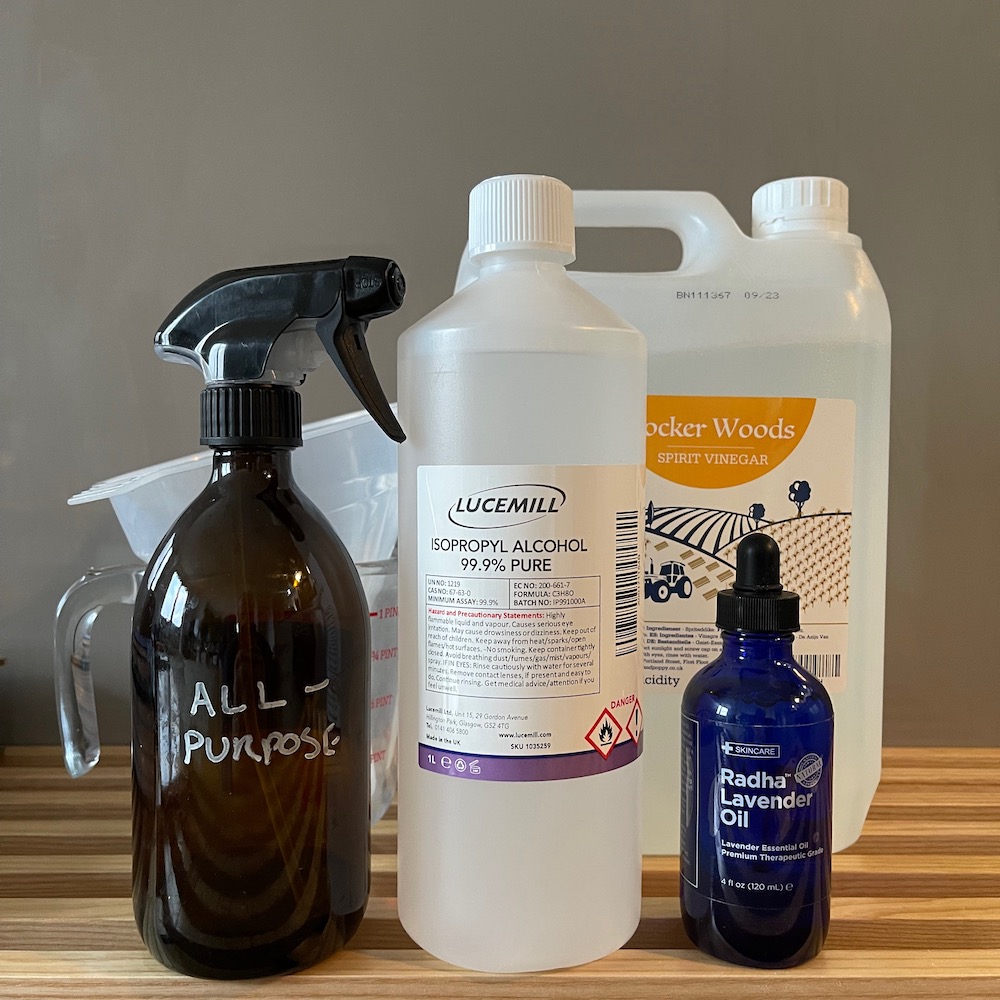
To make it, mix:
- 60ml white vinegar
- 150ml water
- 40ml surgical spirit
- 20 drops essential oil
This fills around half my bottle, and it needs a refill about every month.
I use this everywhere - on my (painted) walls, on bathroom surfaces, on skirting boards and light switches. I keep it in my kitchen caddy though, as I use it most often to wipe down my work surfaces and cupboards.
The product is much less successful on stainless steel and glass, as it tends to smudge - so I use dish soap and warm water on those only.
Floor cleaner
I’ve become an obsessive hooverer (I get my small wireless upright out and give my floor a quick blast between meetings at work sometimes as a de-stresser) but my wooden floors still often looked worse for wear, especially around the kitchen counters and my desk.
I’d bought a couple of specialist wooden floor cleaners that had lovely packaging but weren’t very effective: I was never sure how much I should be using, and how damp the mop I was using to spread it on the floor should be.
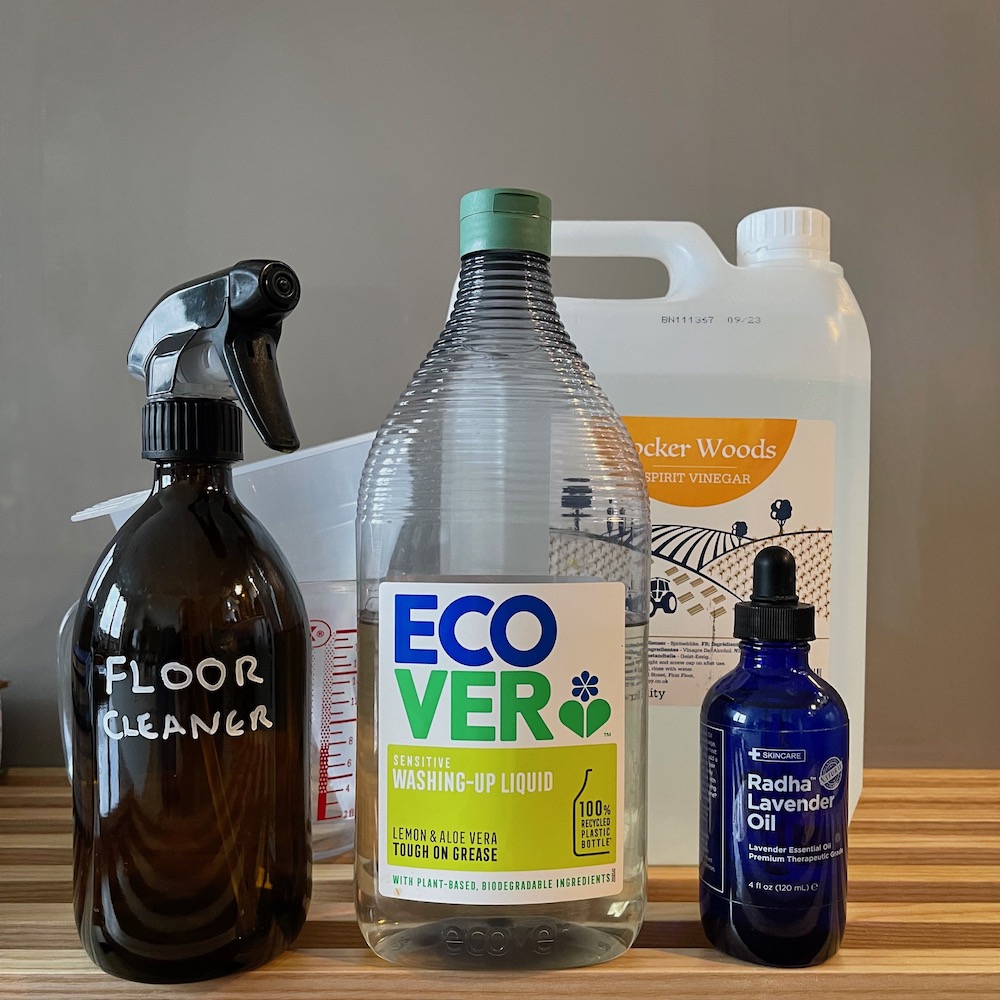
To make the floor cleaner, mix:
- 200ml white vinegar
- 50ml washing up liquid
- 30 drops essential oil
Let it settle so the bubbles from the dish soap die down, and it’s ready to use. I spray a good quantity of the floor cleaner on the high use areas, then use an e-cloth mop, made slightly damp but not wet, to activate it.
Results were really good: it cut through the grime way more efficiently than any specialist cleaner I’ve previously used, never mind soap and water.
I also use it on my bathroom tiles with a damper mop. Solid success.
Dishwashing
I’m not a big fan of my dishwasher - it seems to take hours to do something I could achieve in the sink in a couple of minutes - but wanted to give it another go with non-toxic cleaning products.
I made up the detergent to Nancy’s exact specifications, combining green bleach, soda crystals and bicarb. Using white vinegar, surgical spirit and vegetable glycerine, I made up her eco-friendly rinse aid. And decanted them into my brown glass bottles, as usual.
I ran a couple of dish wash cycles using these products and the results were… OK? In that the dishes were pretty clean and the glasses didn’t have any noticeable staining.
I did notice some cloudy bits on some glasses, which required some extra rinsing, and seemed to be from the detergent leaving deposits. Which kind of negated the utility of using the dishwasher in the first place.
Given the fact I don’t leave a lot of dishes to wash - living alone and all that - I pretty much gave up on the dishwasher as a whole, and now have the new detergent and rinse aid, plus some older (toxic) tablets and some dishwasher salt gathering dust in my kitchen cupboard.
Instead, I just use a dish tub in my and wash up at the end of each day with water and dish soap - which is probably only really practical if it’s just you you’re dishwashing for. Nancy does advise in her book to give the detergent a good mix before each use so that the sodium percarbonate, the most likely culprit for the streaking, is distributed evenly in the mix. But that seems just too much to bother with, for me and for now.
Sink cleaning & bicarb
Not using the dishwasher means my kitchen sink gets a whole lot more action, which in turn means it gets grubby, fast.
Following Nancy’s advice, I keep a sugar shaker of bicarb by the sink, and shake some in there each night once I’m done with the washing-up. You can activate it with a hard brush, working it into the surface: the sink will be pretty wet from the washing up so it won’t leave any bicarb streaks behind. And it will be a lot cleaner and fresher.
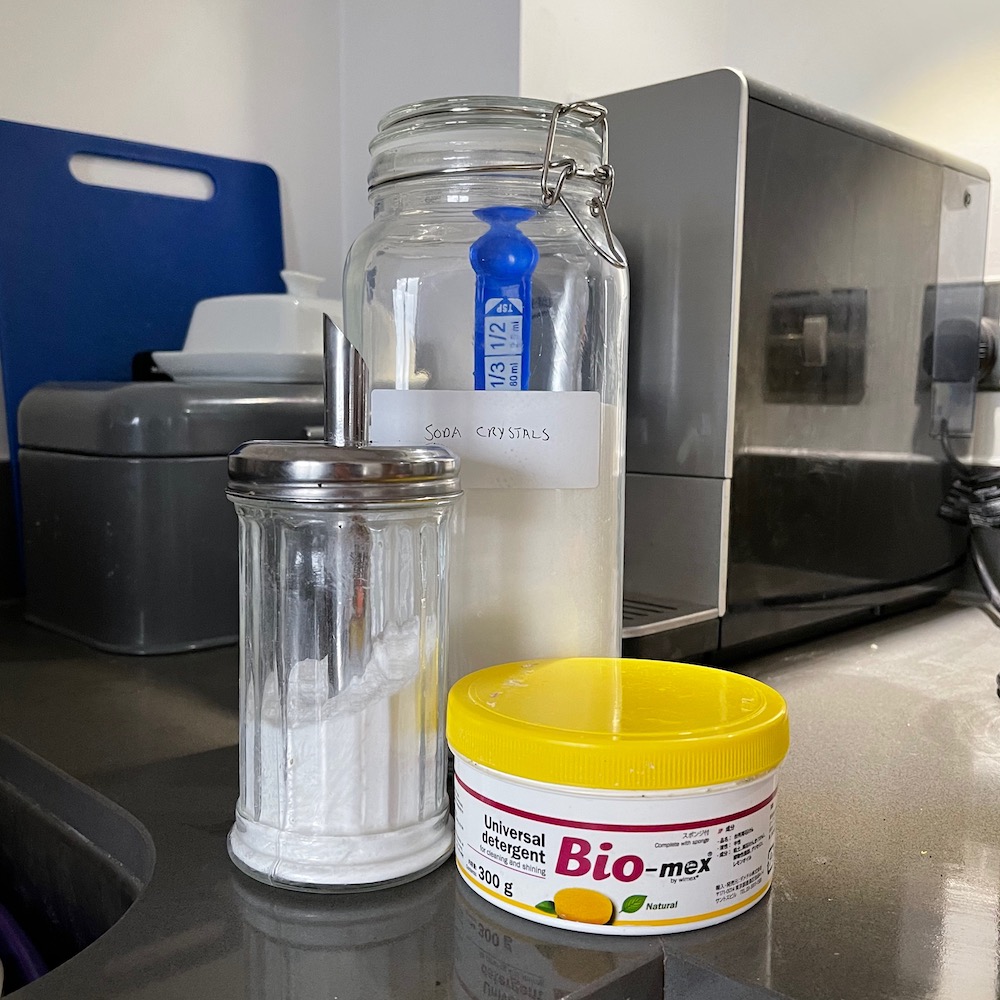
Once a week, I deep clean it with a sponge dug into Bio-mex, which I bought thanks to some Instagram cleanfluencer back in the day, but still use as it has eco ingredients. I’ll try using my all purpose cleaner instead when the Bio-mex runs out.
Finally, I clean the plugholes with a generous scoop of soda crystals, chased down with the contents of a boiling kettle. This is probably the most-cited use of soda crystals, and supposedly helps the sink drain effectively over the long term. I haven’t seen any evidence to the contrary…
Descaling
While I’m pretty much on easy street for cleaning stuff in most respects - living in a small place with no other people to mess stuff up - limescale is huge problem for me. East London’s extra-hard water was a shock to me when I first moved here, and one of my first emergency buys was a water filter, given that tap water here is basically undrinkable.
Left alone, a gross surface crust quickly forms wherever water hits: around taps, on shower screens, in the tub. I’ve used two products quite successfully to deal with this. First, I generally have a bag of lemons in my weekly shop - and tie used halves to taps with a microfibre cloth for a few hours every couple of weeks or so.
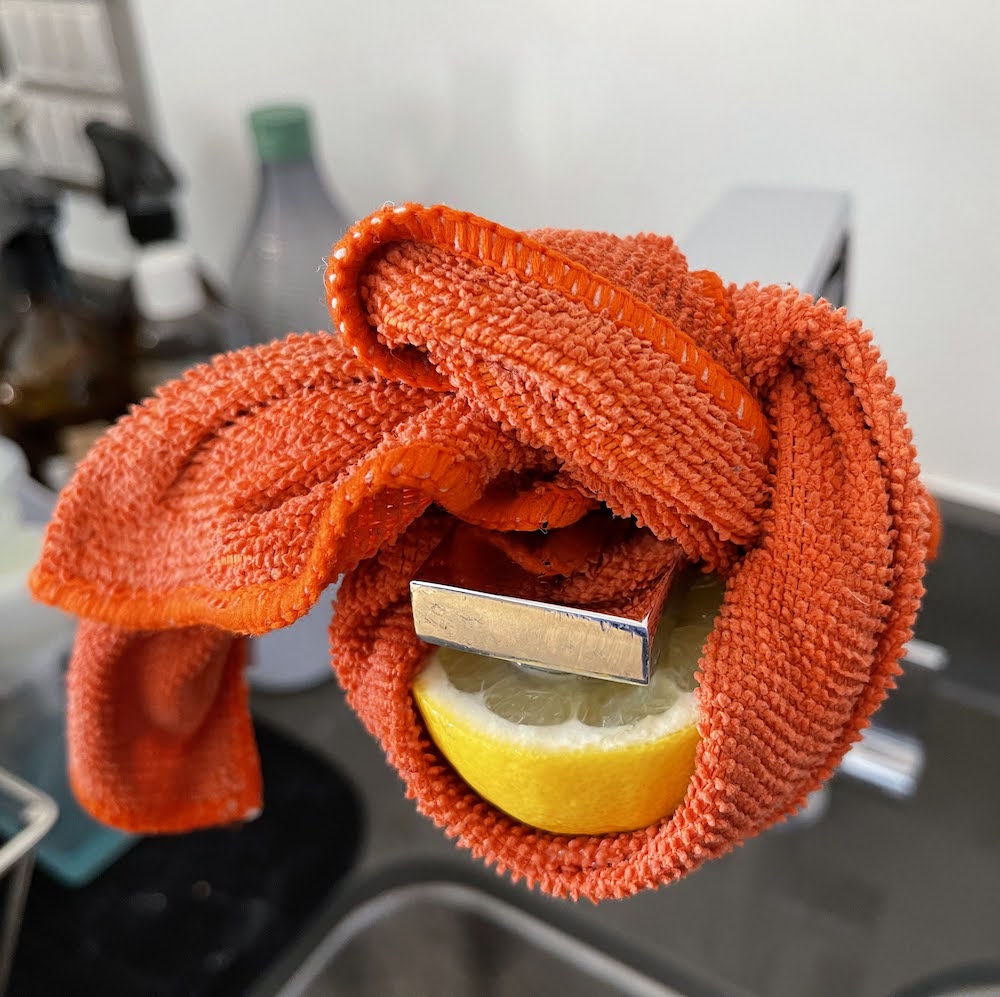
Once untied a satisfying amount of scale flakes off when you wipe the tap head with the cloth.
The rest of it is dealt with with a couple of sprays of white vinegar, left on the surface and wiped off. For the shower screen and my taps (all of which are stainless steel in the flat), this means I have a weekly task :
- wiping all surfaces with soapy water and a sponge (I use my dish washing tub, mixing washing up liquid with warm water)
- wiping the soapy water off with the same sponge (just with water)
- buffing with a dry microfibre cloth
- then spraying with vinegar, and buffing again
This definitely leaves the odd smear if you don’t use a different dry cloth to wipe off the vinegar, but has been effective for me in keeping limescale away. If I don’t do it weekly though, it immediately comes back. Hard water area life.
Toilet cleaning
The most brutal domestic descaling job is generally in the toilet - and that’s where the big guns come out.
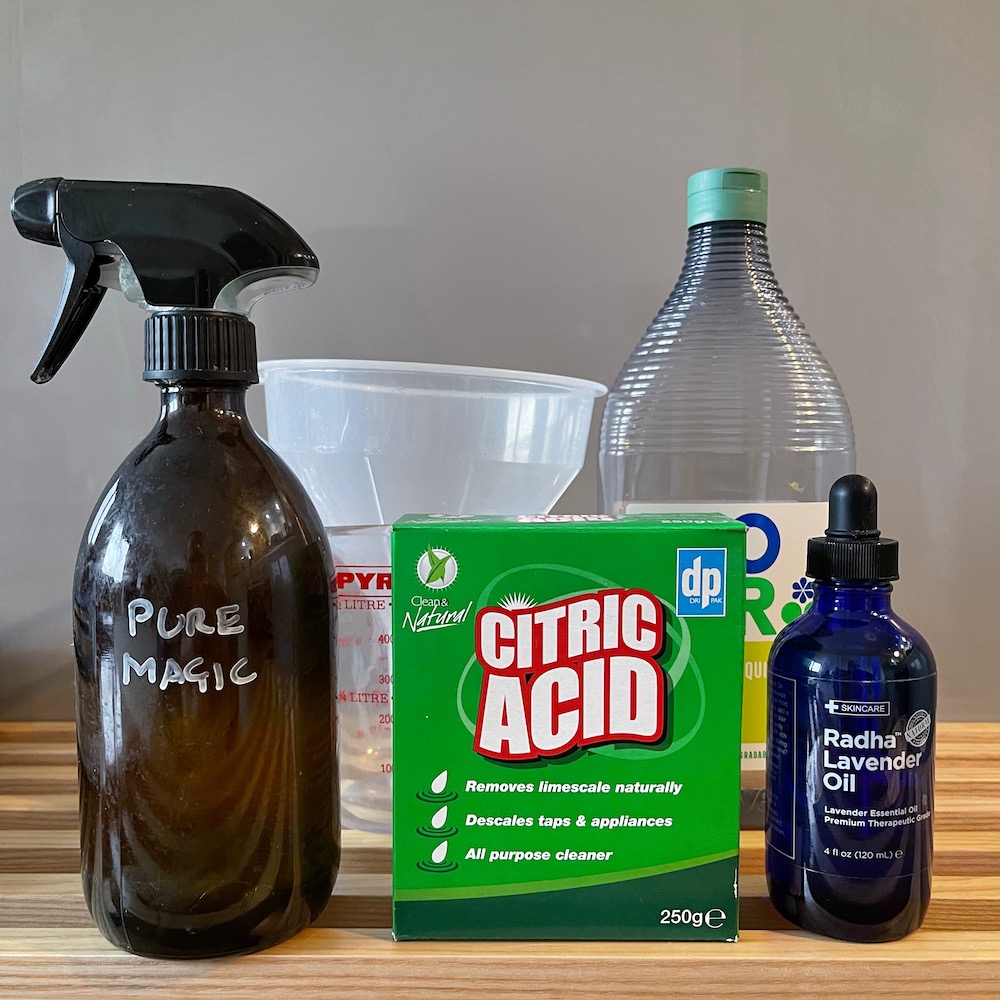
As mentioned above, in Clean and Green Nancy calls the concoction she uses for toilet cleaning ‘toilet magic’. But she’s since rebranded it to ‘pure magic’. This is likely both due to the need for a more generally appealing name, but also because this powerful potion has uses outside of the u-bend. Nancy says you can use it on basically anything that the vinegar and water based all-purpose cleaner hasn’t worked on.
To make it, mix:
- 200g citric acid
- 150ml boiled water
Mix vigorously until the crystals are dissolved, then add 20ml of washing up liquid and 20 drops of essential oil. Leave it to get cold.
I keep the bottle next to the toilet for a daily spray around the bowl. Citric acid is a more powerful acid than vinegar, so it’s extra-effective as a descaler. I have to say that from the smell, it’s powerful stuff, so make sure you’re not in the room for long after you spray.
In line with Dri-Pak’s advice, I also give the toilet a weekly deep clean. Before I go out for the day (important as you need to leave the toilet this way for a couple of hours), I pour roughly half a pack of citric acid down there, followed by boiling water from a kettle. Lower the lid to seal in the steam and activate the acid.
When you’re back, give the bowl a good going-over with your brush. When I first did this, I was really taken aback by how effective it was - the super-gross hard encrusted limescale lurking in the u-bend and around the rim shifted immediately, where chlorine bleach had only temporarily covered it up.
The bleach went into the cupboard straight away, and I haven’t had the need to use any since.
Oven cleaning
I’ve had a pack of Oven Mate in my flat for months now. The product’s intended for cleaning the oven. But the warnings on the package were so terrifying that I chickened out from actually using it after buying. This in turn meant my oven got impressively grimy.
(Did you know that Oven Mate’s own safety information states that you should “drench the affected skin with running water for 10 minutes or longer” if any of the product comes into contact with you and recommends the use of “tightly fitting safety goggles" during use?)
As a more eco and less scary alternative, I used Dri-Pak’s Liquid Soda Crystals a few times; fuller instructions are here. The process basically involved rubbing a significant part of a bottle into every nook and cranny of the oven, leaving for a couple of hours, then sponging it all out with water. I was pretty happy with the result, though I can’t pretend that it left the oven perfectly sparkling clean. There’s still a lot of caked-on grime around the metal sections on the top and the lightbulb. Then again, I didn’t need to put on a full hazmat suit to apply the cleaning product, just a pair of rubber gloves!
I had total success with cleaning my racks and baking trays though. Following a tip from Michelle’s Instagram, I ran a warm bath, dumped in several scoops of soda crystals, and left everything in overnight. My bathtub looked truly revolting the next morning when everything was drained away, but literally all the grime and grease came straight off the racks when rubbed with a cloth. Magic!
Happily, I’ve chucked the Oven Mate out, and entered cleaning the oven out as a monthly task on Todoist. Hopefully, more of the grime will shift each time.
Some conclusions
So that’s where I’m at so far. I’ve changed the way I do laundry. I use my own products, in their smart brown bottles, to clean surfaces from countertops to toilet. I follow Mrs Hinch for the lolz, purely - though she doesn’t seem like a bad person, just a bit of a grifter!
I still don’t lead a notably eco friendly life. I use a bunch of toxic products (mainly for my bike) and have a few more I don’t use, but haven’t thrown out. Lurking in the back of the picture below, just visible, is a big full bottle of chlorine bleach and some Elbow Grease degreaser. Just in case?
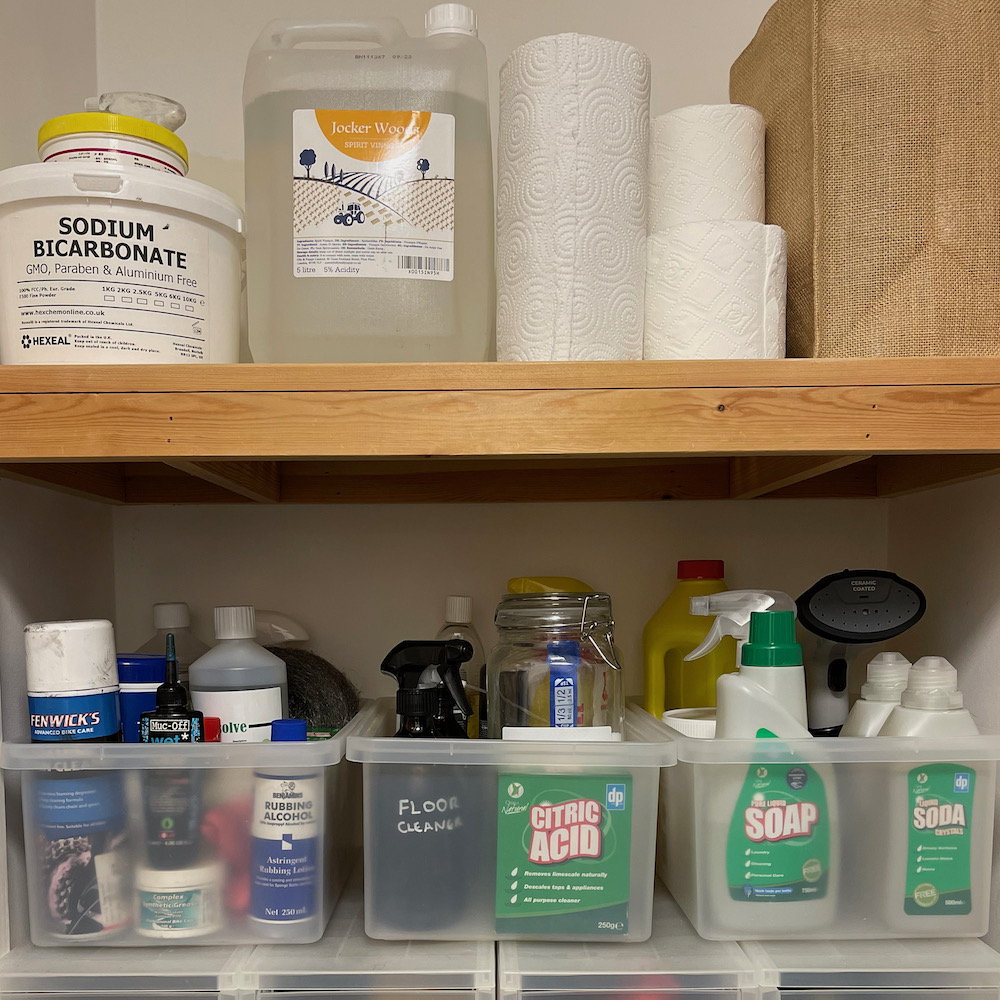 My cleaning cupboard after the switchover. With some toxic bike cleaners on the left - I haven’t switched over those yet.
My cleaning cupboard after the switchover. With some toxic bike cleaners on the left - I haven’t switched over those yet.
One thing’s for sure though - I’m not going back. Since my initial Amazon spend, I haven’t spent a penny on any cleaning product not made by Dri-Pak. And with soda crystals going for 75p a bag, these spends are going to be consistently low in the months ahead.
And in case I haven’t spelt this out clearly enough yet, my flat is still spotless. Come visit! Just don’t touch or move anything, and don’t think about going into the cleaning cupboard.